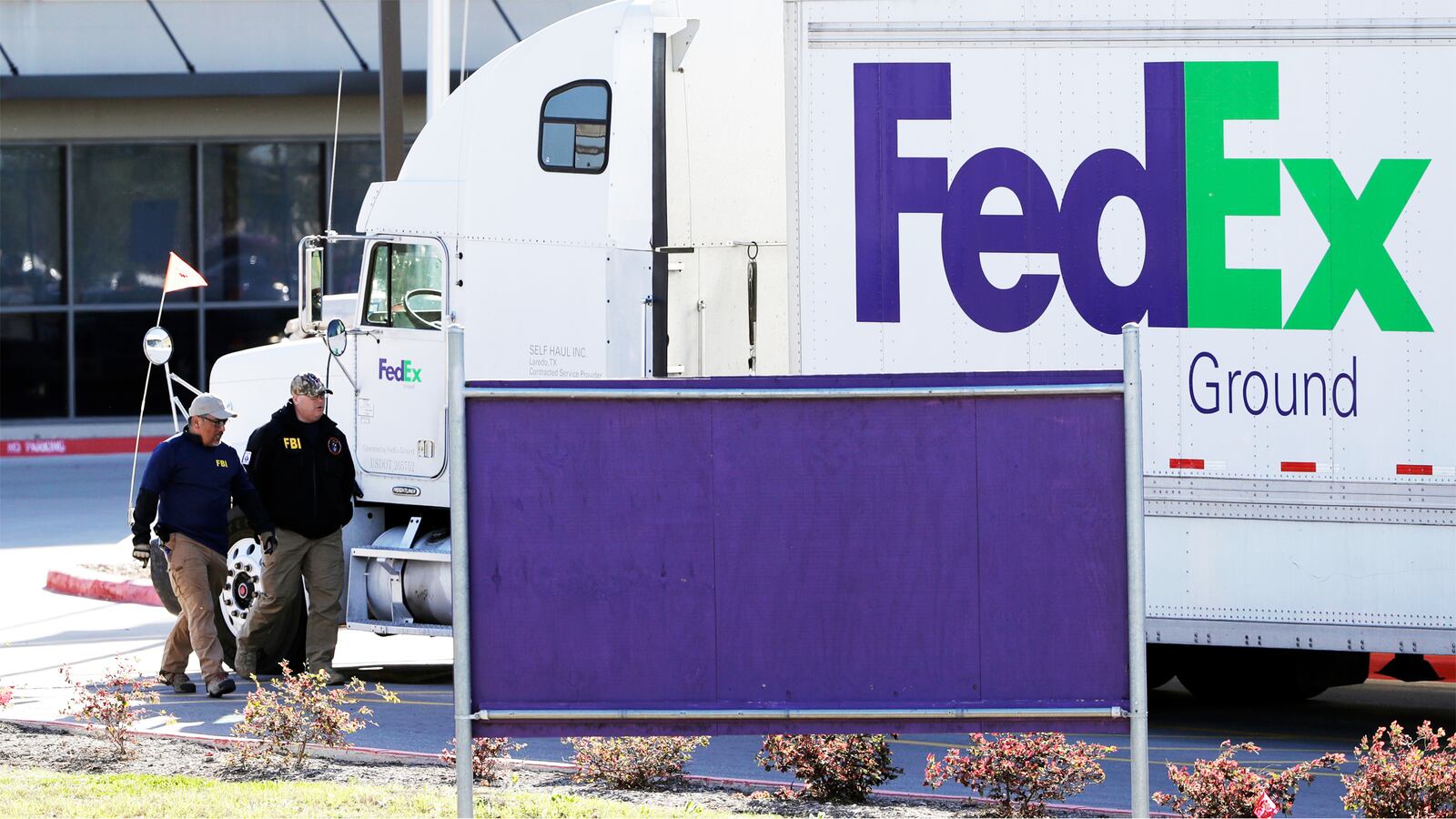A parcel bomb destined for Austin, Texas exploded Tuesday morning at a FedEx facility before reaching its apparent target—but even that failure shows the bomber is more sophisticated than previously thought, experts told The Daily Beast.
Even though police say the explosion at a FedEx facility near San Antonio didn’t hit its intended target, experts claim the failed attempt shows a new level of sophistication and capriciousness than they even saw the day before—when two men were seriously injured by a tripwire bombing in a residential neighborhood in Austin.
Five bombs in the past month have killed two people and injured four others in Texas, and set state, local, and federal law enforcement on a mad dash to find and stop the seemingly random attacks.
The latest came just after midnight on Tuesday, when a mid-sized package bomb exploded, minorly injuring a woman at a FedEx facility in Schertz outside of San Antonio. Unlike the first bombs that were planted in person, this device was reportedly addressed to a location in Austin—and marked as coming from an Austin address.
“It would be silly for us not to admit that we suspect it’s related,” FBI Special Agent Michelle Lee told the Associated Press.
Notably, Tuesday’s package contained nails and other metal scraps, similar to the four previous explosions that have rocked the Texas capital since March 2.
Brian Jenkins, an analyst with Rand Corp. who has studied bombings and terrorism for four decades, told The Daily Beast on Tuesday that the bomber has demonstrated “skill” and “prowess” based on the number of detonations that have ended in death or serious injury.
“The intense publicity provides a sense of power,” said Jenkins. “He is evading the authorities, the FBI, the police, the ATF, and he’s the center of attention. People are frightened, which in turns leads to more attention to him. There’s a compulsion here.” (Jenkins and several other experts have all noted that in nearly all modern American cases, convicted bombers have been men.)
“I suspect that whoever is responsible will be reading whatever is written about them,” he continued. “Whatever the police say, that person is now a consumer.”
Jenkins also noted that the attacker is “extremely busy” and has kept up an unusual pace.

The first three package bombs all detonated on Austin’s east side. Anthony Stephan House, 39, and 17-year-old Draylen Mason were killed. In the third bomb, a 75-year-old Latina resident was wounded. Each of those packages were hand-delivered to the victims’ front porches. Mason’s mother was also seriously wounded in one of the attacks.
The fourth bomb, which wounded two men on Sunday evening in southwest Austin, was detonated via a tripwire anchored by a yard sign.
Ten days separated the first bombing from the next two, but Sunday’s attack happened just six days later. Less than 30 hours later, the FedEx bomb exploded.
“Now it’s two days between devices,” former FBI profiler Clint Van Zandt, who is credited with helping identify Ted Kaczynski as the Unabomber, told The Daily Beast on Tuesday.
“That ramps up the threat, it ramps up the danger, and it says the bomber or bombers are watching the media,” he said. “They’re watching what law enforcement is doing, and they’re evolving very quickly with the type of devices, the timing of devices, and the way the devices are triggered to explode.”
But even with all that’s publicly known about the attacker, his motive has proved elusive.
Jenkins noted that, based on what’s publicly available, the Austin bomber is likely not conducting a terrorist campaign.
“There is nothing obvious, if all of these explosions are connected, that indicates some sort of political message or intention to affect policy,” Jenkins said. “That simply isn’t there yet.”
“It would be obvious or it would be communicated,” he continued, “Terrorism is about communication.”
Still, other patterns, potentially based on a personal grievance, might be harder to discern, Jenkins said. He pointed to two separate bombing cases in recent American history, in which police struggled to determine a motive in the beginning.
For instance, in the 1980s, the “Alphabet Bomber” attacked the Pan Am Terminal at Los Angeles International Airport before allegedly engaging in a larger plan to attack places in an order that would make an anagram of “Aliens of America,” beginning with “A” for airport. In 2002, Luke Helder planted pipe bombs in mailboxes throughout the country and allegedly planned to create a smiley face shape on a map.
“There are patterns in these things, even if on the outside we are completely baffled,” Jenkins said.
As far as Tuesday’s packages are concerned, Jenkins said the use of a FedEx facility seemed to be an “operational consideration.”
“On the one hand they want to keep going, but on the other hand they don’t want to be caught,” he said.
Former ATF agent Malcolm Brady told The Daily Beast on Tuesday that the bomber’s “success” is also not an accident.
“He’s probably built one of these devices before and detonated it before—maybe in the desert or the woods,” said Brady, who served in various posts at ATF over 34 years and supervised the 1993 World Trade Center bombing case. “They may get a little more sophisticated, but with any luck, he’ll blow himself up.”
“He’s a smart man that can put these devices together and not kill himself,” said Brady. “Obviously he’s been reading.”
Jenkins agreed, noting, “People don’t suddenly decide one day: I’m going to be a bomber.”
—With additional reporting by Kelly Weill.






